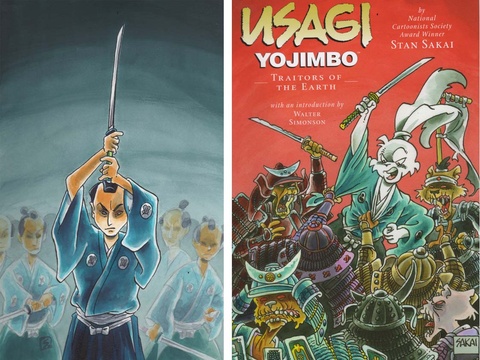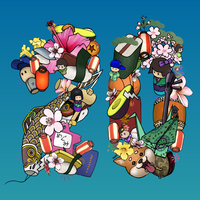Ears drooping in the heavy rain, Usagi Yojimbo glances around menacingly and draws his sword to defend against attackers. Always ready to defend his honor and help those weaker than him, this samurai hero is the star of a highly successful comic book series Usagi Yojimbo (“Rabbit Bodyguard”), created, written, and illustrated by Japanese American artist and writer, Stan Sakai. A product of the multi-cultural artistic nexus that is Los Angeles, the series is unlike any other comic book series from the U.S. or Japan: the characters, settings, and imagery are Japanese, yet it is written in English and Sakai’s drawing, lettering, and narrative style originate mostly in the West. Also, the hero is a rabbit.
The idea of creating a comic book about a rabbit samurai came to Sakai in the early 1980s, shortly after he had moved to Los Angeles. He had grown up in Hawai‘i, a third-generation Japanese American exposed to both Japanese and American culture. As a child, he devoured DC and Marvel comic books and was particularly fond of Spider-Man and Batman. Though he didn’t read Japanese, his mother read him Japanese comic books, or manga, like Astro Boy by the “father of Japanese manga,” Osamu Tezuka (1928-89).
Sakai studied art at the University of Hawai‘i and soon knew that he wanted to write and illustrate for a living. He decided to move to Los Angeles, the center of the American animation industry and increasingly comic book illustration, and after a few semesters at Art Center College of Design, he began drawing and lettering for comic books.
At some point in the early 1980s, he had the idea of creating a comic book about a samurai based on Miyamoto Musashi (c.1584-1645), a renowned swordsman of superhuman strength. One day when he was idly doodling, Sakai drew a picture of a rabbit with his ears tied together in a samurai’s topknot, or chonmage, and Usagi Yojimbo was born. In 1984, the character was included in an anthology, and three years later, the first full comic book of the adventures of Usagi Yojimbo was published. These stories of a masterless rabbit samurai who occasionally sold his services as a bodyguard quickly acquired an enthusiastic following.
More than 25 years later, Sakai has published more than 200 comic books (combined into 26 graphic novels) and the special volume Space Usagi, and he has won multiple awards, including several Eisners, for the comic series. His expressive characters and intricately drawn depictions of traditional Japanese life have not gone unnoticed in the fine art world. In 2011 (the year of the rabbit), his work was the subject of a solo exhibition at the Japanese American National Museum in Los Angeles, a rare achievement for a comic book artist. Sakai is currently working with writer Mike Richardson and manga giant Kazuo Koike (as consultant) on a comic book version of Japan’s famous legend 47 Ronin.
The popularity of Usagi Yojimbo may be in part linked to the growing appeal here in the U.S. of Japanese comic books, or manga. With content ranging from action-adventure and romance, to sports, historical drama, fantasy, and even business, Japanese manga are typically printed in black and white, their pages packed with the exploits of expressive, big-eyed characters from real and imagined realms. Usagi Yojimbo, however, actually has very little in common with contemporary manga other than the Japanese content and black-and-white imagery, as Sakai himself has been known to point out.
“My influences come more from Japanese cinema than Japanese manga or anime,” he explains. “I am a big fan of Akira Kurosawa and Hiroshi Inagaki. My work has been inspired by films like Kurosawa’s Seven Samurai, Yojimbo, and the Hidden Fortress and Inagaki’s Samurai Trilogy—not just the characters and themes but also the pacing of my story-telling.”
It is in these three aspects of Usagi Yojimbo where Sakai succeeds the most. His characters, all anthropomorphized animals, are so thoughtfully evolved that it is easy to forget that they are animals. The loyal and honorable Usagi Miyamoto is engaged in a warrior’s pilgrimage in order to better himself. His sidekick Gen, a rhino bounty hunter whose motives are more often financial than noble, is equally as appealing, as are the many minor characters they encounter, like the feisty and noble-spirited female cat Sakura, who can defend herself against any number of male ruffians. Themes of loyalty, honor, and generosity are explored with both drama and humor in a series of episodic tales of Usagi’s journey from town to town. In one riveting episode, Usagi and Gen help Sakurai rescue a young girl who has been sold by her poor family to the owner of a gambling establishment. By defeating him, they release the girl from servitude and unite her with her mother. Each of these tales is built up carefully scene by scene, reaching its conclusion at a satisfying pace for any age.
Clearly, honor and loyalty are qualities that are important to Sakai himself. In his tales of Usagi’s exploits, he honors the culture of his Japanese ancestors, painting rich visual and narrative portraits of an important time in the country’s history. He depicts the towns, architecture, clothing, weapons, and other objects in each scene with meticulous attention to detail—evidence of his extensive, scholarly research. He also possesses the generous spirit of an educator, keen to share what he has learned about Japanese history, religion, and folklore with those who read his comics. In one episode, his characters explain how soy sauce is made; in another, the characters (and readers) learn about the nine-tailed fox, a mythical creature believed to bewitch travelers. Sakai even takes great care to explain with friendly footnotes words like metsuke (the shogun’s spies) and hakama (baggy trousers).
Sakai is modest about his creative generosity. “I write for myself,” he claims. “I have always written stories that interested me. Creating a comic book set in Japan has allowed me to learn so much about my own culture. I have the best job in the world.”
* Usagi Yojimbo is currently published by Dark Horse Comics. More information can be found at www.usagiyojimbo.com and at Dark Horse’s Usagi Yojimbo page.
This was the final article in the “Japanese Accents” series showcasing Southern California artists whose works integrate elements of Japanese art and design, yet speak boldly about our contemporary SoCal lives. Some are Japanese American; others have no blood connection with Japan but have discovered something Japanese that resonates with their artistic vision. It was originally published on KCET Artbound on November 28, 2012.
© 2012 Meher McArthur / KCET















